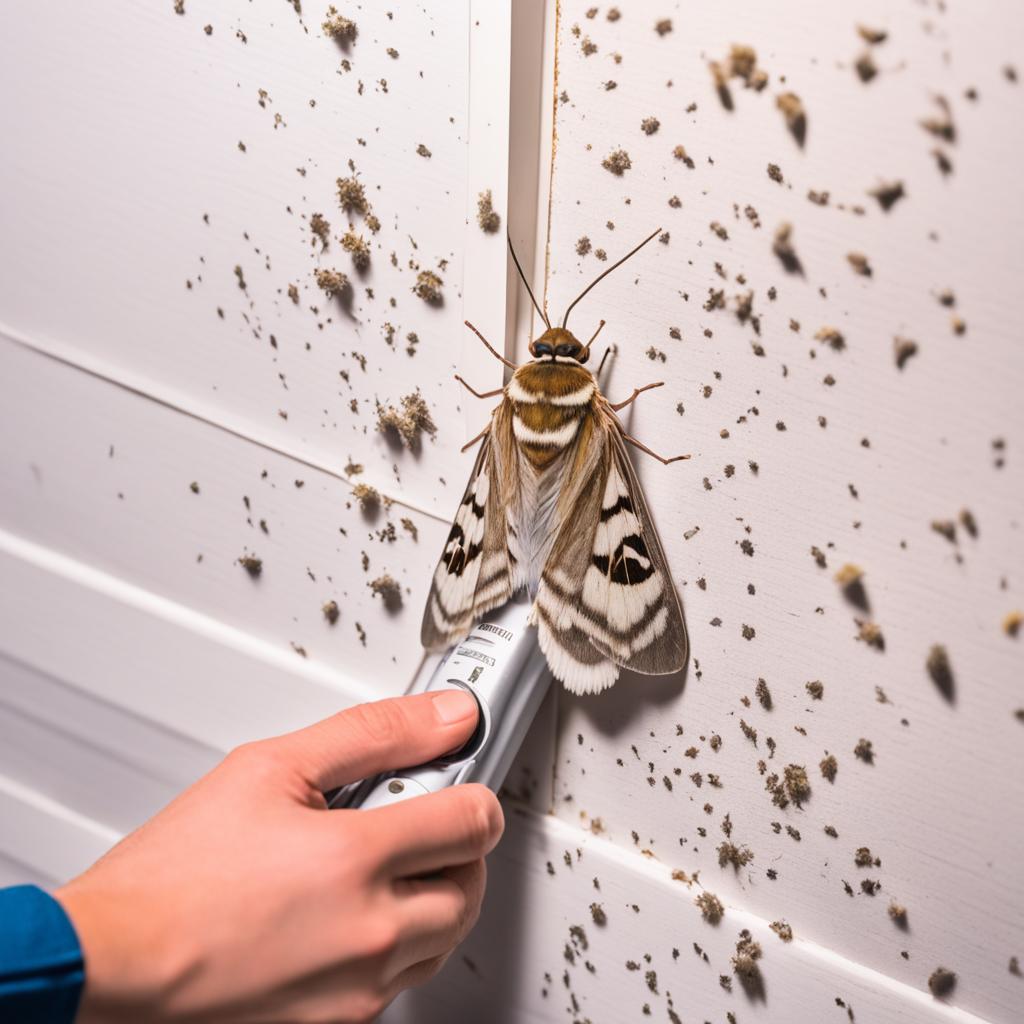When it comes to dealing with pests in our homes, we often focus on the usual suspects like ants, spiders, or rodents. But what about moths? These seemingly harmless insects can cause quite a nuisance, especially if they find their way into our living spaces. So, the question remains: can moths actually travel through vents?
Join us as we uncover the truth behind moth behavior and their ability to navigate our homes through the unseen pathways of vents. You may be surprised by what you learn about these winged intruders and how they can infiltrate even the most unsuspecting corners of your living space.
Detecting Moths in Your Home

When it comes to keeping your home free from moths, early detection is key. By recognizing the signs of a moth infestation, you can take immediate action to prevent further damage. Here are some common indicators that moths may have made their way into your home:
- Bare spots or holes in clothing, drapes, or carpets: Moths are known for their ability to feast on natural fibers, such as wool or silk. If you notice small holes or areas of fabric that appear to be worn out, it could be a sign that moths are present.
- Casings from moth larvae or dead moths: Moth larvae shed their outer skins, leaving behind small casings. These can often be found near windows, lighting fixtures, or air vents. Additionally, finding dead moths around your home may indicate an active infestation.
- Moth eggs on fabrics or furniture: Moth eggs are tiny and difficult to spot with the naked eye. However, they are typically laid on natural fibers and can be found on clothing, carpets, fabric, or furniture. Inspecting these areas closely may reveal these minuscule eggs.
To better understand the signs of a moth infestation, take a closer look at the image below:
Regularly inspecting and cleaning areas where moths are likely to infest is crucial in keeping your home moth-free. By taking action at the first sign of moths, you can protect your belongings and maintain a pest-free environment.
| Signs of Moth Infestation | Action to Take |
|---|---|
| Bare spots or holes in clothing, drapes, or carpets | Inspect affected items and discard damaged ones. Launder or dry-clean clothes and fabrics to eliminate any remaining moths or larvae. |
| Casings from moth larvae or dead moths | Vacuum the affected areas, paying close attention to corners, cracks, and crevices. Dispose of the vacuum bag or clean the vacuum thoroughly. |
| Moth eggs on fabrics or furniture | Wipe down surfaces with a damp cloth to remove any eggs. Consider using moth-repellent products, such as cedar balls or lavender sachets, to deter future infestations. |
By staying vigilant and recognizing the early signs of a moth infestation, you can take appropriate measures to detect and eliminate moths from your home.
Types of Moths Found in Homes

When it comes to moths found in homes, there are three common types that you should be aware of. These include webbing moths, casemaking moths, and pantry moths. Each type poses its own unique challenges and requires targeted control measures to effectively manage the infestation.
Webbing Moths
Webbing moths, also known as clothes moths, are notorious for infesting and damaging animal-based fibers such as wool, fur, and feathers. They are attracted to dark, undisturbed areas in your home, making your wardrobe a prime target. These moths lay their eggs on natural fibers, and once the larvae emerge, they proceed to feast on your favorite clothing items, carpets, and drapes.
Casemaking Moths
Similar to webbing moths, casemaking moths are another species that feed on animal-based fibers. They derive their name from the protective case that their larvae create using silk and bits of fiber, which they carry around as they move. This portable shelter allows the casemaking moth larvae to feed on a wider range of surfaces, ensuring a more extensive and destructive infestation.
Pantry Moths
Pantry moths, also known as Indian meal moths, are a common nuisance in kitchens and pantries. These moths infest dry goods such as grains, beans, nuts, and dried fruits. You might first notice their presence when you discover webbing or silken strands in your food packages. Pantry moths can quickly contaminate your stored goods, rendering them inedible and potentially causing health issues if consumed.
To effectively address a moth infestation in your home, it’s crucial to identify the specific type of moth you are dealing with. This will help you implement targeted control measures to eradicate the infestation and prevent it from recurring. Now that you’re aware of the types of moths commonly found in homes, you can take the necessary steps to protect your living space and belongings.
Preventing Moths in Your Home
To prevent moths from infesting your home, it is important to take preventive measures. By implementing the following steps, you can help create a moth-free environment.
- Block potential entry points: Inspect your doors and windows for any cracks or openings that moths can use to enter your home. Seal these gaps using weatherstripping or caulk to prevent moths from gaining access.
- Seal ventilation ducts and air conditioning units: Ensure that your ductwork and vents are properly sealed to prevent moths from entering through these routes. Use duct tape or sealant to close any gaps or openings.
- Use screens or barriers: Install window screens and door sweeps to keep moths out while allowing fresh air to circulate. In areas where moths are more prevalent, such as near gardens or wooded areas, consider using mesh barriers for added protection.
- Store clothing and fabrics properly: Moths are particularly attracted to clothing and fabrics made of natural fibers. To safeguard your belongings, store them in airtight containers or garment bags. Additionally, consider using moth repellents, such as cedar chips or lavender sachets, to deter moths.
- Regularly clean and vacuum: Moths are attracted to food sources such as crumbs, pet dander, or dead insects. Clean your home regularly, paying special attention to areas prone to moth activity, such as closets, pantries, and corners. Vacuum carpets, upholstery, and curtains to remove any moth eggs or larvae that may be present.
By following these preventive measures, you can significantly reduce the risk of moth infestations in your home and ensure a moth-free environment for you and your family.
Dealing with Moth Infestations in Apartments

Moth infestations can be particularly troublesome in apartment complexes due to the close proximity of residents and the potential for moths to travel between units. To effectively deal with moth infestations in apartments, it is essential for residents to be proactive and report any signs of moths to the property management. Prompt action is crucial to prevent the spread of infestations throughout the building.
Regular inspections play a crucial role in identifying and addressing potential moth problems. Property management should implement coordinated pest management programs to ensure thorough inspections are conducted in all units and common areas. These inspections help in detecting early signs of moth infestations and allow for swift intervention to prevent further damage.
In addition to inspections, proper sanitation practices are key in controlling moth issues in apartments. Residents should maintain cleanliness in their units by regularly cleaning and vacuuming areas where moths are likely to thrive. This includes spaces such as closets, pantries, and storage areas.
Creating awareness among residents about the importance of prevention and cooperation is vital. Encourage the community to take responsibility for their own units by promptly addressing any signs of moths or infestations. This collaborative effort can significantly reduce the occurrences of moth infestations in the apartment complex as a whole.
Moth Prevention Tips for Apartment Residents:
- Regularly inspect and clean your unit to identify any signs of moths or infestations.
- Report any sightings or concerns to the property management immediately.
- Seal cracks and openings in windows, doors, and walls to prevent moths from entering.
- Store clothing and fabric items in sealed containers or garment bags to protect them from moths.
- Maintain cleanliness in common areas by disposing of trash properly and cleaning up spills promptly.
- Use moth-resistant products, such as cedarwood or herbal repellents, to deter moths from entering your apartment.
By following these preventive measures and actively participating in efforts to control moth infestations, residents can help create a comfortable living environment in apartments free from the annoyance and damage caused by moths.
Hidden Challenges in Moth Infestations
Addressing moth infestations can pose various hidden challenges that require careful consideration. One of the primary obstacles is identifying the hidden food sources that sustain the moth population. Moths have the ability to emerge from unexpected areas, including ventilation ducts, electrical or plumbing pipe chases, and construction voids. These secluded spaces can serve as breeding grounds, allowing moth populations to thrive undetected.
Thorough Inspections: To effectively control moth populations, thorough inspections are essential. By examining all potential hiding spots, such as ductwork or concealed crevices, you can identify the presence of moths and their food sources.
Pheromone Traps: Utilizing pheromone traps can help pinpoint entry points and determine the extent of the infestation. These traps release synthetic versions of the female moth’s mating pheromones, attracting and capturing male moths. By strategically placing these traps, you can gain valuable insights into the infestation’s scope.
Cameras for Inaccessible Areas: In some instances, inaccessible areas may require the use of cameras to observe and assess potential moth infestations. These cameras can be used to inspect tight spaces or hidden voids where moth larvae or eggs may be present. This method allows for precise detection and targeted treatment.
By availing of these techniques, you can successfully locate and eliminate hidden food sources, ultimately gaining control over moth infestations.
| Challenges | Solutions |
|---|---|
| Identifying hidden food sources | Thorough inspections, pheromone traps, and cameras for inaccessible areas |
| Preventing re-infestations | Sealing entry points, regular cleaning, and maintenance |
| Implementing effective control measures | Proper sanitation, targeted treatments, and monitoring |
Tips for Preventing Moths in Apartments
As a resident in an apartment, there are steps you can take to minimize the risk of moth infestations. To prevent moths from entering your living space, it is crucial to block potential entry points. Check for any cracks or openings in doors, windows, or walls and seal them to keep moths out.
Proper storage of clothing and belongings is also essential in preventing moth infestations. Make sure to store your items in sealed containers, such as airtight plastic bins or vacuum-sealed bags, to minimize access for moths. Regularly cleaning and vacuuming your living space is another effective way to remove moth eggs, larvae, or potential food sources.
If you notice any signs of moths in your apartment, such as holes in clothing or dead moths, it is important to report them to the property management immediately. By working together with the management, prompt action can be taken to address the issue and prevent the spread of infestations throughout the complex.
Furthermore, consider using moth-resistant products to deter moths from entering your apartment. Specially designed garment bags or sachets containing cedarwood or herbal repellents can help repel moths and protect your clothing and fabrics. By implementing proper sanitation practices and fostering a cooperative effort among residents and management, you can effectively prevent and control moth infestations in apartment complexes.
FAQ
Q: Can moths travel through vents?
A: Yes, moths can travel through vents in homes and buildings. Female moths are attracted to dark and undisturbed areas and may enter vents in search of a suitable place to lay their eggs. They can crawl or fly into vents through cracks or openings around windows, doors, or air conditioning units.
Q: How can I detect moths in my home?
A: Signs of moths in your home can include bare spots or holes in clothing, drapes, or carpets, as well as the presence of moth larvae casings or dead moths near windows, lighting fixtures, or air vents. Moth eggs, although tiny and difficult to spot, are often found on natural fibers in clothing, carpets, fabric, or furniture.
Q: What types of moths are commonly found in homes?
A: The most common types of moths found in homes are webbing moths, casemaking moths, and pantry moths. Webbing and casemaking moths, also known as clothes moths, eat animal-based fibers such as wool, fur, or feathers. Pantry moths, or Indian meal moths, feed on dry goods stored in pantries, such as grains, beans, or nuts.
Q: How can I prevent moths in my home?
A: To prevent moths from infesting your home, it is important to block potential entry points, such as cracks in doors or windows, seal ventilation ducts, and use screens or barriers to keep moths out. Additionally, store clothing and fabrics made of natural fibers in airtight containers or garment bags, and regularly clean and vacuum your home to eliminate potential food sources for moths.
Q: How do I deal with moth infestations in apartments?
A: Apartment complexes can be susceptible to moth infestations due to the close proximity of residents. Infestations can occur when neighboring residents ignore or fail to address their own moth problems. It is important for residents to be vigilant and report any signs of moths to the property management to ensure prompt action is taken to prevent the spread of infestations.
Q: What are the hidden challenges in moth infestations?
A: One of the challenges in addressing moth infestations is identifying hidden food sources that sustain the moth population. Moths can emerge from areas such as ventilation ducts, electrical or plumbing pipe chases, or construction voids. Thorough inspections, the use of traps to pinpoint entry points, and possibly the use of cameras to inspect inaccessible areas may be required to find and eliminate these hidden infestations.
Q: What tips can you provide for preventing moths in apartments?
A: As a resident in an apartment, you can minimize the risk of moth infestations by blocking potential entry points, storing clothing and belongings properly in sealed containers, regularly cleaning and vacuuming your living space, and reporting any signs of moths to the property management. Using moth-resistant products, such as specially designed garment bags or sachets with cedarwood or herbal repellents, can also help deter moths from entering your apartment.
